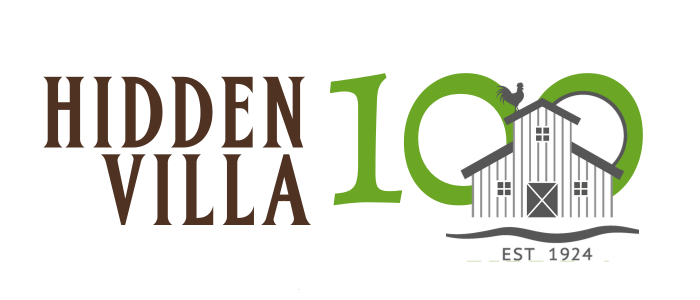
We’re celebrating 100 years of Hidden Villa, 100 years of stories, and 100 years of memories. Below is a collection of inspiring stories from you, our Hidden Villa community from over the past century. We invite you to share your cherished Hidden Villa memories with us, as you are apart of Hidden Villa’s rich history. Click the button below to share your cherished memory, transformative experience, or heartwarming tale.
Share Your Story
A (Volunteer) Jack of All Trades
[IMG Here]
Diane Ciesinski has held many roles at Hidden Villa since she first started volunteering in the 90s. She’s helped with event publicity, served as an unofficial historian, spent seven years as a board member with two as chair. But her favorite role to date just may be farm tour leader for kindergarten and first grade students.
“Being a farm tour guide is really special,” Ciesinski said. “When the kids learn where their food comes from and pet the animals, you get to see the wonder in their eyes. I love seeing the magic in action.”
Ciesinski discovered the magic of Hidden Villa by accident, while searching the Yellow Pages for the phone number of a business that began with the letter “H.” She found what she was looking for and then noticed a listing for Hidden Villa.
Ciesinski called Hidden Villa out of a sense of curiosity and arranged to visit. “I took a tour,” she said, “and fell in love.”
She is one of thousands of volunteers who have helped out at Hidden Villa over the past 100 years in a variety of roles that range from administrative tasks to working on the farm to leading tours.
In addition to serving as a board member and marketing assistant, Ciesinski wrote recipes for a newsletter for members of the Community Supported Agriculture (CSA) program. She became a CSA member herself, and is today the longest continuously registered member.
When Hidden Villa summer camp turned 50, she did a research project to learn more about the history of camp, and even created photo albums of campers through the decades.

And she has shared her love for Hidden Villa with others. When Ciesinski’s dad, Bob Niederer, retired, he became a volunteer with Hidden Villa, where he led farm and wilderness tours for 20 years. He remarried there in 2002, and in 2021, Niederer’s memorial service was held at Hidden Villa.
In 2013, Ciesinski delivered a talk about sustainable agriculture to students at the Tokyo University of Agriculture and Technology in Sendai, Japan, where they had endured a devastating tsunami and were beginning to start new farms. Hidden Villa staff helped Ciesinski prepare her talk.
“One of the many great things about Hidden Villa is the incredible community of people that come together day in and day out to make what we do possible,” said Elliott Wright, executive director. “Diane has put her heart and soul into this organization for over three decades, and it is because of her and people like her that we are even here today to celebrate our centennial anniversary.”
As to what her next volunteer endeavor may be, Ciesinski isn’t sure. All she is sure of is that she will be a part of Hidden Villa for as long as she is able.
“I get energized there,” she said. “I can see the teaching of the next generation and it gives me hope that kids want to learn about farming, sustainability, and social justice.”
By Kate Levin
More Hidden Villa Stories
Remembering Summers at Hidden Villa
I was introduced to Hidden Villa by Dr. Robert Bullock, a family friend who took me to the ranch to “see the little pigs”. I fell in love with the place (especially the baby pigs) at first sight and was fortunate enough to spend the summers of 1965 and 1966 as a summer camper. I was a Cabin Boy my first summer and a Bluff Boy as a nine year-old. I have fond memories of Josephine Duveneck teaching us folk dancing in the big house and her husband Frank pulling a trailer full of hay with his tractor on evening hay rides. One of my prized possessions is a handwritten postcard from Mrs. Duveneck to my mother commending my progress in my second year as a camper. Today, some sixty years later I take great pride in seeing my granddaughter serve as a summer camp counselor at Hidden Villa. -Gaither Loewenstein
A Renewed Life
Hidden Villa has been central to my new retired life. I join forces with my hiking group weekly and over the last 2 years have walked the beautiful trails with bay and ocean vistas, watching the growth of trees, bushes and flowers and becoming intimate with the entire environment. -Andrea Mirenda
Horses to Harvest
(The following is an excerpt from an interview with Jason McKenney, Agriculture Director) “…The story is mostly about Andy Scott. He was the farm manager here before me. He came to Hidden Villa first in 1991. He’d been a beekeeper and a gardener in the Central Valley for many years and was well-known within the organic farming community. Andy was hired at Hidden Villa in 1991 and at the time was managing just about everything agricultural property-wide. He managed the education garden and the farm program, which was pretty different back then. He took care of all the animals, and just about every aspect of the property including irrigation systems, fences, EVERYTHING. People call it a farm or the ranch now, but at that time it was much more of a ranch, and largely because of our lack of water there really hadn’t been much gardening or agriculture practiced here. The one exception was the ‘frying pan field’ (the field near the white house), which was actually the first garden space at Hidden Villa, long before it was Hidden Villa. The Duvenecks were huge horse people. They had a big horse corral in the area along Moody Road. There were Los Altos Hills town events with horses in partnership with Westwind Barn. A lot of people in this area had horses, many still do. The Duvenecks boarded horses on the fields where we now have the farm. It was really overgrazed. I’ve seen pictures of it from 1988. It was just dirt. Andy started to transform that. He began growing a few things in the areas that had been overgrazed. He started small and built upon his successes. Then, he started having intermittent pasture animals, mostly ruminants, to graze. One of the biggest innovations he made early in his time here was to our agricultural irrigation system. He described to me on many occasions, hands down, the biggest challenges that he had were water and irrigation. They’re really the same challenges we face today. How do you set up an irrigation system that’s not going to get clogged because the water has so many sediments in it? And how do you use our limited resources of water the most responsibly? Early on in his time here, he invested in drip irrigation hose, the same hose in fact that we still use today. Andy started buying some of those in the mid to late ’90s. They were developed only in the early ’90s. If we didn’t have that incredibly water-conserving irrigation, we wouldn’t be capable of growing here at all.” -Jason McKenney (he/him), Agriculture Director





